#clothing manufacturers in bristol
Explore tagged Tumblr posts
Text
Top Wholesale Clothing Manufacturers for High-Quality Fashion in Bristol

Embrace the epitome of fashion with Alanic Global, the foremost wholesale clothing manufacturers in Bristol. Elevate your retail business with our top-notch apparel offerings. https://www.alanicglobal.com/uk-wholesale/bristol/
#wholesale clothing manufacturer bristol#bristol wholesale clothing#clothing manufacturer wholesale bristol#bristol clothing manufacturer#clothing manufacturers in bristol#bristol wholesale clothing manufacturers#wholesale clothing vendors in bristol#bristol wholesale clothing vendors
0 notes
Text

Wholesale Clothing Manufacturers Bristol
Manufacturers specialize in affordable, bulk fashion. They offer a wide range of quality apparel for all ages, ensuring trendy options for retail markets. https://www.alanicglobal.com/uk-wholesale/bristol/
#bristol wholesale clothing#bristol wholesale clothing suppliers#wholesale clothing manufacturers bristol#wholesale clothing bristol
0 notes
Text

Alanic Global: Leading Clothing Supplier in Bristol
Alanic Global is a top-rated clothing supplier in Bristol, offering a wide range of trendy and high-quality apparel for men, women, and children.
#custom clothing wholesaler in Bristol#bespoke clothing manufacturers in Bristol#clothes manufacturer Bristol#wholesale clothing Bristol#wholesale clothes Bristol#clothing supplier Bristol
0 notes
Text

Clever clothes: Seams in clothing capture body movement
Everyday clothing may soon be able to capture and record body movements according to new research published by the Universities of Bristol and Bath. Harmless low voltages are passed through conductive threads which are stitched into garment seams to create electrical circuits. Their resistance changes with the movement of the wearer's body. The work opens up new possibilities to make digital clothing which senses and captures movements much more accurately than is possible using current phones and smart watches. The paper, presented at the Designing Interactive Systems (DIS) conference in Copenhagen on 3 July, lays the foundations for e-textile designers and clothing manufacturers to create cutting edge garments that could enhance exercise, physiotherapy and rehabilitation.
Read more.
10 notes
·
View notes
Text

Castle Combe; often named as the ‘Prettiest Village in England.'
Castle Combe, a medieval village and civil parish within Cotswolds area of outstanding natural beauty in Wiltshire, England.
The village has a rich history and the houses are made up of the honey coloured Cotswold stone, typical for a village of this area.
The village takes its name from a castle built on the hill to the north of the village in the 12th century AD, of which little now remains except earthworks.
No new homes have been built in the historic area since 1600s AD.
During the Middle Ages, the village, along with much of the Cotswolds, enjoyed prosperity due to the growth of a thriving wool industry.
Within Castle Combe, you’ll find a Market Cross and St Andrew’s Church, which dates from the 13th century AD.
The church houses a faceless clock, which is reputed to be one of oldest working clocks in the country.
Numerous weavers’ cottages were erected from local stone, and these ancient honey-hued buildings remain one of the village’s standout features today.
The village was known in particular for manufacturing a red and white cloth known as ‘Castlecombe,’ which was renowned in the markets of Bristol, Cirencester, as well as London and abroad.
In 1440 AD, King Henry VI granted Castle Combe the right to hold a weekly market, with unmistakable Market Cross monument still standing proudly today.
Castle Combe strictly banned all modern attachments such as TV dishes and external wires to the exterior of its houses, restrictions that have been instrumental in helping the historic village to maintain its authentic appearance.
As a result, the village has become a popular location for film crews, with productions including the 1967 filmed musical Doctor Dolittle, Stardust, and The Wolf Man were all shot within the village.
Castle Combe was a key filming location for Stephen Spielberg’s War Horse.
To recreate a 1914 setting, the village’s tarmac through-road was closed and covered with a temporary muddy surface.
Its modern street lamps, signage, and post boxes were either covered or removed altogether. Its white window frames were repainted with more muted colours.
📷 : Credit to the Owner
#Castle Combe#Cotswolds#Wiltshire#England#medieval village#Middle Ages#Market Cross#St Andrew’s Church#Castlecombe#King Henry VI#filming location#weekly market#market town#12th century#1100s#medieval history#medieval architecture#stone buildings#English village
5 notes
·
View notes
Text
youtube
cheap sweater maker,italy sweater factory,made to measure sweaters
YS-SWEATER MANUFACTURING https://sweatermanufacturing.com
Email:[email protected]
cheap sweater maker,italy sweater factory,made to measure sweaters fork dress,Baby sweater bespoke,pullover man anime,kids knitted dress,winter suits and sweater,girocollo maglione uomo,pullover online,planet by lauren g sweater,sueterreflectivo,thermal tops casual long sleeve pullover sweater,mens streetwear cardigan,switer cowok,long skirt sets women 2 piece outfits,sweater designs for kids,black bape sweater,long sleeve sweatshirt pullover plain women hoodie,style knitwear,nfl fleece pullover,womens clothing black jumper,ladies cardigan sweater, hoodie for men,cardigan 1 hr,v pullover herren,drawstring women pullover,uñas efecto sueter,2 piece sets womens outfits,zeta phi beta sweater,cardigan rainbow,plus size womens tshirts,cheap sweater maker,italy sweater factory,made to measure sweaters customized denim jumper,Women’s sweater customization https://sweatermanufacturing.com/customized-denim-jumperwomens-sweater/ cheap sweater maker,italy sweater factory,made to measure sweaters 90s vintage sweaters,sweater gilmore,sweater knit fabric yard,knitting custom scarf,100ashmere sweater,graphics fleece pullover dtg printing hoodie,making ugly christmas sweaters,rare canle yellow canle flower machine 3d jaquard girls womens cotton rib knit sweater,sweater comb,striped jumper men,sweater two piece set,what to wear with cardigans female,women sweater cardigan clearance,cardigan quays limited,i have a sweater on,woollen jumper,fleece stripes pet,fleeces go outdoors,in cashmere sweater,soft thick sweater,fsu cardigan,sweater hush puppies,pullover set staking women korean,zeagoo women pullover hoodies sweatshirt long sleeve,women pullover, jersey knit cotton,cheap sweater maker,italy sweater factory,made to measure sweaters maker’s mark christmas sweater,susan bristol sweaters manufacturers,custom made labels for knitting https://sweatermanufacturing.com/makers-mark-christmas-sweatersusan/ cheap sweater maker,italy sweater factory,made to measure sweaters aka v neck sweater,sweater for parrot,adult knit top,sweater kaise banate hain,pullover 500 gsm,dongguan fangqiang wool knitting,knitting custom orde,sueter 1 boton,women's 3/4 sleeve cotton cardigan,kids math pullover clothes coat,sueter de bebe a crochet paso a paso,streetwear hoodies sweaters,nylon sweater for men,h hyfol mens usa flag graphic pocket pullover,oh lala pullover,sexy backless cotton dress,amir sweater,costum jumpers men,iceberg trui,fleece sweater shirt and tie,knit christmas sweater,sweater maternity dress,high quality designer sweaters,canguro para cargar a los bebe forma de sueter de adulto,fleece sweater moose jaw,printed hoodies hooded sweatshirt,polo sweaters,cheap sweater maker,italy sweater factory,made to measure sweaters knit chinese wave stitch,manufacturer defect holiday sweaters,Women’s sweater oem https://sweatermanufacturing.com/knit-chinese-wave-stitchmanufacturer/ cheap sweater maker,italy sweater factory,made to measure sweaters oversized mohair sweater,leopard print cardigan,pullover robes for women,sweater quotes fall,sueter hello kitty,zaket and plover sweaters,bright handmade sweaters,casual long sleeve cable knit open front sweater,crochet patterns for women's cardigans,kaponlu hirka erkek,patchwork pullover tracksuit,fleece by the yard,cardiganno8,uñas diseño sueter,high quality knit crewneck wool,hoodie sweater bull,cardiganuniqlomurah,designer sweater,turtle neck women 100otton sweater,gran sasso knitwear,women sweatsuit pullover,sueters camuflados,matching knitwear,cardigan quiz
0 notes
Text
CFMOTO joins Fowlers line-up


Fast-growing motorcycle brand brings variety and value to Bristol bikers. CFMOTO is joining the line-up at Fowlers, offering bikers in Bristol and beyond an unrivalled choice of new machines. A relatively new brand in the UK, CFMOTO is rapidly gaining in popularity, due to the impressive variety of bikes in the range and accessible OTR prices. It will sit alongside 15 other manufacturers currently represented in Fowlers’ central Bristol showrooms. The growing CFMOTO line-up has something for riders of all tastes. The neo-retro 300CL-X and 700CL-X Heritage, priced at £3,599 and £5,999 respectively, are sure to be a hit with fans of modern classics. At just £4,499 the super-sharp 649cc, liquid-cooled, fuel-injected parallel-twin 650NK offers an effortless and engaging naked bike experience, perfect for newer riders looking to step-up.

For those who want to really broaden their horizons, the range-topping 800MT Touring dual sport feels equally at home on a mountain trail as it does on the motorway. Its impressive spec includes a DOHC liquid-cooled 799cc twin-cylinder engine, KYB suspension and Cornering ABS; all this and more available at an OTR price of only £9,199. A rapidly growing brand, CFMOTO was founded in 1989 and currently employs around 5000 people. The firm sold 127,000 new bikes worldwide in 2021. It was also the first new manufacturer to enter the Isle of Man TT for over 50 years. In 2016 a WK650i - ridden by TT legend Gary Johnson - finished fourth in the Lightweight class, missing out on a podium by just 2 seconds.

Alongside the choice of new machines for sale, CFMOTO owners can benefit from routine servicing and maintenance in Fowlers’ fully-equipped on-site workshops, with comprehensive spares back-up from Fowlers Parts, the largest stockist of genuine motorcycle parts in the UK. A huge selection of clothing and accessories are also available, as is the option to refuel and relax in Harry’s Café on the mezzanine above the showroom floor. Find out more about the CFMOTO range and book a test ride at fowlers.co.uk View our dealer news section for more news: Dealer News For more information on Fowlers Motorcycles products visit www.fowlers.co.uk Read the full article
0 notes
Text
E-Textile Market Latest Industry Trend, Challenges, Strategy 2021 to 2030
There have not been many commercial successes with e-textiles up to this point. This is attributed to the healthcare industry's unwillingness to invest in academic or research endeavors in favor of a wait-and-see attitude. Some manufacturers have substituted wellness/sports sector in its place, where repercussions of a false signal are significantly less severe.
However, with chronic diseases such as diabetes, heart disease, cancer, and respiratory disorders continuing to rise in many parts of the world, older populations living longer, and increase in the number of surgeries performed in important healthcare markets such as Europe and the U.S., e-textile developments are on the rise to utilize cutting-edge electronics and medical technology. In some clinical studies, smart clothing has demonstrated the ability to guard against infectious diseases, sense the wearer's health status, and aid in the prevention, treatment, and management of health.
Request for sample:-https://www.alliedmarketresearch.com/request-sample/16469
E-textiles must continue to evolve in terms of dependability, liability, and certification to overcome obstacles. Device producers and researchers face additional difficulties with regulatory approvals because getting FDA approval might take years. Then comes the challenge of receiving certification and permission from insurance companies. The development of the several smart clothing concepts that have been proposed would take three to five years. Many experts predict that this turning moment will occur around 2020.
University-level research shows great promise for the future of patient care technology among those creating e-textiles for the healthcare business.
The VTT Technical Research Center in Finland is working on an intriguing project where researchers have developed smart fabric that can be worn as clothing or blankets and determine whether a patient needs to be warmed or cooled based on initial data measured from person and environment. Thegear adapts to body's temperature during surgery, hence it might also be utilized by doctors who feel too warm during an operation.
Request For Customization:-https://www.alliedmarketresearch.com/request-for-customization/16469
The ElectroScience Laboratory at Ohio State University is developing useful e-textiles that gather, store, or transmit digital information by weaving antennas into objects such as brain caps that sense brain activity to help treat conditions such as epilepsy or addiction. These antennas use platforms such as the Intel Edison development platform. Researchers are also developing a smart bandage that can communicate with a doctor about the state of surrounding tissue's healing without having to remove it.
While this is going on, researchers at the University of Bristol are developing soft robotic clothing that could prevent falls in people who are vulnerable by supporting them while they walk and provide bionic strength to people who need it to get from a sitting to a standing position or climb stairs. Nanotechnology, 3D printing, electrical stimulation, and full-body monitoring technologies are all used in creation of smart clothes. As per opinions of various researchers this technology could ultimately lead to potentially freeing wheelchair-bound people from having to use the devices.
The Empa research institute in Switzerland has developed a fitted cap that measures heart rates and is incorporating optical fibers into e-textiles to monitor skin circulation and avoid bed sores. Hospitals find the clothing to be perfect as it can endure a disinfecting wash cycle.
This technique, according to researchers, may one day be used to gauge tissue pressure, respiration rate, or oxygen saturation. To examine bodily fluids or gases, e-textiles could also be made into chemical or biological sensors such as those provided by Maxim Integrated. Based on a series of ultra-low power ARM® Cortex®-M microcontrollers from Maxim, ultra-low power and secure development boards are available. These ARM Cortex-M4F 32-Bit MCUs combine ultra-low-power, high-efficiency signal processing functionality with user-friendliness, making them perfect for the growing category of wearable medical and fitness applications. The integrated pulse oximetry and heart-rate monitor module from Maxim, the MAX30102 Pulse Oximeter & Heart-Rate Sensor, has inbuilt LEDs, photodetectors, optical components, low-noise electronics with ambient light rejection, and it also has low-power electronics.
Even though many of these research projects are progressing and working toward commercialization, new developments in microelectronics and high-tech fabrics are expanding the potential applications for healthcare-related e-textiles.
Purchase enquire:-https://www.alliedmarketresearch.com/purchase-enquiry/16469
Some of these concepts and early pilot projects include t-shirts that treat chronic back pain, shirts with stretch sensors to track respiratory rates in people with chronic lung disease, soft all-day belly bands to track fetal heart rate and uterine contractions in pregnant women, pressure monitor stockings for people with diabetes, or even a shirt that shocks people with severe heart problems.
According to some experts, shirts that monitor heart rate, blood pressure, oxygen saturation, and other metrics will eventually totally replace bedside monitoring in hospitals.
With the Google-Levi Project Jacquard commuter jacket for cyclists, the concept of using gesture detection in smart clothing has recently gained prominence. There are currently much more affordable and well-established technologies that will be difficult to surpass in the next five years, despite the fact that many experts believe gesture recognition could find its way into clothing for healthcare—possibly for use by paraplegics, elderly who have suffered strokes or heart attacks, or elderly in the home who fall.
It can be easily shrunk and does not require moving mechanical elements, haptic feedback, or the use of touch in a user interface design, hence holds a lot of potential for e-textiles. To engage a patient's muscles, haptic feedback, which can be anything from a slight tickle to a powerful force input, is employed in electric muscle stimulation (EMS). To stimulate muscle movements or for rehabilitation, smart clothing with haptic feedback technology might be worn on any region of the body at any hour of the day. Prototypes of haptic feedback-based projects, like those from Novasentis, are now being created for use in medical apparel and should be available later this year.
The e-textile market is segmented on the basis of type, product, application, functionality, and region. On the basis of type, the E-Textile Industry is bifurcated into classic electronics and modern electronics. By product, it is classified into passive, active, and ultra-smart. On the basis of application, it is categorized into defense, sports & fitness, healthcare, household textiles, fashion & entertainment, transport, protection & military, architecture and others. On the basis of functionality, it is classified into sensing, energy harvesting, luminescence & aesthetics, thermoelectricity, and others. Region-wise, theE-Textile Market is analyzed across North America, Europe, Asia-Pacific and LAMEA.
The players operating in the global e-textile market have adopted various developmental strategies to increase their E-Textile Market Share, gain profitability, and remain competitive in the market. The key players included in the E-Textile Market Analysis are- CARRÉ TECHNOLOGIES Inc., Chronolife., E. I. DU PONT DE NEMOURS AND COMPANY , INTERACTIVE WEAR AG, Mitsufuji Corporation, Myant Health , Outlast Technologies GmbH , sanSirro GmbH , Schoeller Textile AG, SENSING TEX, S.L. , Sensoria Inc. , SunstarTaiwan ENT. CO., LTD. , Tex-Ray Industrial Co., Ltd., TORAY INDUSTRIES, INC., Vista Medical Ltd., Vulpés Electronics GmbH, Xenoma Inc.
Key findings of the study
On the basis of product type, the classic electronics segment is projected to witness the major E-Textile Market Growth with the CAGR of 6.5%, in terms of revenue, during the E-Textile Market Forecast period.
On the basis of product, the ultra-smart segment E-Textile Market Size is expected to dominate the market from 2022 to 2031.
On the basis of application, the defense segment has the high E-Textile Market Trends and is expected to grow at a significant CAGR during the forecast period and has myraid E-Textile Market Opportunity.
On the basis of functionality, the sensing functionality segment dominated the global market in the 2021, with a E-Textile Industry share of more than 30%.
Region wise, Europe dominated the global market in 2021. This is attributed to expansion of new wholesale fabrics companies and surge in E-Textile Market Demand for apparel and textile machinery exports for e-textiles.
0 notes
Text
Reading Week Homework
For our reading week homework, we were tasked to research two brands that we find inspirational.
The first brand I chose was Lucy & Yak, an independent, ethical clothing retailer specialising in dungarees. I find the story behind the brand inspirational, as partners Lucy Greenwood and Chris Renwick began by selling vintage clothing on Depop out of their van, before finding a business partner in India, who started to manufacture their signature dungarees. The guiding principles behind the brand are comfort and sustainability, creating long lasting, high quality clothing with a focus on ethical working practices, both in terms of people and the planet. Lucy & Yak, as a brand are entirely certified by the Global Organic Textile Standard (GOTS), which means that all steps of the textile supply chain have been regulated to meet the 'requirements for both ecological and labour conditions'. Lucy & Yak also use paper mailing bags to ship their orders and biodegradable plastic to protect individual products, and are working to offset their carbon emissions, partnering with various organisations to plant a current total of 29,086 trees.
I think that Lucy & Yak's brand identity is unique, as the story behind the brand and the owner's journey is a driving force across all their advertising, including their website, Instagram and tiktok, allowing for a more 'personal' and community based relationship with their consumers. They currently sell online and have 3 stores in Brighton, Bristol and Norwich. I also feel that Lucy & Yak differ from other ethical or sustainable clothing brands, in terms of their use of a vibrant colour palette and bold graphics (often florals or patterns) in their advertising and on the products themselves.
The customer demographic for this brand varies but is predominantly women in their late 20s-30s, with inclusive sizing ranging from a UK women's size 4-32. Whilst a lot of the clothing could be seen as quite youthful in terms of it's bright colours and playful patterns, I think the primary demographic doesn't include teens, due to the price point being somewhere between £40-90 for a pair of dungarees and £6-£30 for smaller accessories, such as hats, socks and cushions/tea towels made out of deadstock fabric.


The second brand that I have researched is Stella McCartney, a luxury brand that produces high end, ethically sourced clothing, bags and beauty products. The brand has been strictly vegetarian, inline with Stella McCartney's personal beliefs, since it began, as well as having a strong focus on sustainability. Ways in which the brand promote sustainability include, using certified organic cotton, recycled nylon and polyester and 'clevercare', a garment labelling system explaining how to properly care for the clothes in order for them to last longer and therefore reduce consumer consumption. The brand also looks at sustainability in their packaging and since 2012, have only used paper that is FSC (Forest Stewardship Council) certified or made from 50% recycled content. Stella McCartney have also joined Fashion for Good's polybag collection scheme, collecting plastic garment bags from their London store and sending them for recycling.
Stella McCartney is a high-end brand, targeting wealthy customers and celebrities with clothing ranging from £200-£3000 and £50-£140 for beauty products. As well as online shipping to 40 different countries, products are sold in 46 stores across New York City, London, Paris, Milan, Tokyo, Shanghai and Beijing. One of the brand's most iconic products is the 'Falabella' bag, the 'original vegan luxury tote bag, characterised by its slouchy silhouette and diamond cut chain'.



0 notes
Photo

Alanic Wholesale is one of the top-notch Wholesale Clothing Manufacturers in Bristol
Alanic Wholesale is one of the top-notch Wholesale Clothing Manufacturers in Bristol, the UK, with a premium quality custom clothing collection.
#wholesale clothing in Bristol#clothing manufacturers in Bristol#Bristol wholesale clothing suppliers#clothing wholesale in Bristol#clothes wholesale in Bristol#wholesale clothing manufacturersin in Bristol#Bristol wholesale clothing distributors#wholesale clothing distributors in Bristol
0 notes
Text
Knowing that the difference between profit and loss might well be a matter of whether or not they complied with the Navigation Acts, Beekman and his correspondents didn’t scruple at evasive measures—bribing customs collectors, doctoring ships’ manifests, circulating fraudulent bond certificates, and outright smuggling. After Parliament passed the Molasses Act in 1733, such conduct became almost a way of life. Planters on Guadeloupe, Martinique, and other islands of the French West Indies responded to the law by offering premium prices for North American provisions and asking less for sugar and molasses than did their British counterparts. When it became evident that customs officials were making only halfhearted attempts at enforcement, the profitability of illicit trade for North American merchants was assured. (It may have accounted for one-third of all northern commerce.) Beekman himself became so accustomed to smuggling that he would complain bitterly if circumstances compelled him to pay full duty on the rum and molasses he imported by way of Rhode Island.
What Beekman and men like him almost never did was invest their profits in plantations. Trade, not production, was the New Yorkers’ forte, and they tended to think of the West Indian plutocracy as wildly dissolute and irresponsible. Nor did more than a handful of them engage in direct trade with England. Local products alone couldn’t fetch high enough prices in the mother country to pay for imported manufactures. Also, because the prevailing winds blew out of the west, getting back to New York from, say, Bristol or Liverpool was a hazardous and time-consuming proposition. Ships outward bound from British ports usually took tropical routes to the New World, dropping down to Madeira to catch the Canaries Current, then winging across to the West Indies and working up the North American coast. Over time, improvements in ship rigging and design—the appearance of the gaff-rigged “schooner,” the development of jib and headsails, and the adoption of the helm wheel—gradually made it easier to sail in the teeth of the westerlies. Even then, however, the majority of New York merchants continued to concentrate on the West Indies and other North American colonies.
The net result was the economic triangulation of three strikingly different systems of production: the small-farm hinterlands of northern seaports, the slave-labor plantations of the Caribbean, and the wage-labor workshops of early industrial England. New York now lived by feeding the slaves who made the sugar that fed the workers who made the clothes and other finished wares that New Yorkers didn’t make for themselves. Along the way, they closed in on their old objective of breaking Boston’s grip on the economies of southern New England. Lying a week closer to Barbados and ten days closer to Jamaica, the city enjoyed a natural advantage over Boston in competition for the lucrative West Indian markets. Inexorably, pressed by Philadelphia’s domination of the mid-Atlantic region, New York merchants took control of the New England coasting trade.
— Edwin G. Burrows and Mike Wallace, Gotham: A History of New York City to 1898 (1998)
6 notes
·
View notes
Text
Premier Bristol Wholesale Clothing Manufacturers for High-Quality Fashion

Discover the epitome of fashion with Alanic Global, leading wholesale clothing manufacturers in Bristol, offering top-notch apparel for your retail business. https://www.alanicglobal.com/uk-wholesale/bristol/
#wholesale clothing manufacturer bristol#bristol wholesale clothing#clothing manufacturer wholesale bristol#bristol clothing manufacturer#clothing manufacturers in bristol#bristol wholesale clothing manufacturers#wholesale clothing vendors in bristol#bristol wholesale clothing vendors
0 notes
Text
The Critique of Manners, Part II
~Or~
A Candid Review of ITV's Emma (1997)
Disclaimer: I do know that both this and the Miramax version were released in 1996, but to avoid confusion, I refer to this one as the “1997 Emma” in reference to the US release date.
The bones of this review were written some six years ago after my initial viewing. I’ve watched it three or four times since then, two very recently (Within the past year). I’d started to soften on it in the most recent watch. So many people love it so much I thought surely maybe I’m just crazy or even wrong; until I found this blog post from 2008 (a year before my favorite version was released) that hit on almost EVERY SINGLE thing that skeeved me out about this version when I first watched it.
Like my previous review of Emma. (2020), I’ll be covering the cast and overall handling of the script in comparison with what I know from reading the book. I will also be commenting on my thoughts about the costumes (Whether they are attractive or accurate, or both, or neither) which will be a bit more in depth than it was for the 2020 version, and this will set a pattern for the costumes section going forward.
Directed by Diarmuid Lawrence with screenwriting by Andrew Davies (Or should I say “Written by Andrew Davies with direction by Diarmuid Lawrence”?), this version was a fan-favorite among Janeites for many years for … well, reasons I’ve never been entirely certain of. I’ve read the book twice through and referenced pertinent passages MANY times besides, and really I don’t see what they’re raving about.
Let’s dive in.
Cast & Characterization
I’d known about this adaptation for a while, but I held off on watching it, largely for one reason: my apprehension about Mark Strong playing Mr. Knightley.
I was concerned because when I watched this I had already seen Mark Strong as Sir John Conroy in The Young Victoria and as Lord Blackwood in Sherlock Holmes, both very unpleasant characters. But there have been several occasions when I expressed displeasure with casting choices only to eat my words when I actually watched the movie. So I entered into watching this with an optimistic outlook, sure that Mark and Kate would surprise me with brilliant performances. And I would like to say that they did, but that would be an untruth.
My biggest fear about Mark Strong playing Mr. Knightley was that his rebuking of Emma was going to be a watered down version of ‘RAAAWWWRRR’ that I was familiar with, specifically because of The Young Victoria. It’s very hard for me to see Mark Strong point his finger in Emily Blunt’s face and shout at her, and then watch him do the same thing with Kate Beckinsale (only somewhat less aggressively) and expect to feel all warm and fuzzy about their romance. I expected that to be a tall order. And it was. Whenever he raises his voice, the right side of his face pulls up into a snarl. Now since it does this no matter what role he’s playing I’m guessing that’s just how his face is. It’s not his fault really and it’s almost certainly unintentional, but I’ve seen that snarl before and it does NOT belong on Mr. Knightley’s face.
Don’t ever think I don’t LOVE Kate Beckinsale, and I don’t necessarily think that my problems with this interpretation of Emma are her fault; these things very rarely fall on the shoulders of the actual actors, but those of the screenwriters and directors who guide them. However – and I am aware that this might sound a bit harsh – I would say that at points, Kate Beckinsale’s performance in this movie (In my opinion) barely outstrips community theatre or even very good high school drama club level acting. It seems to me that there’s burden on her here to sound historical or period. This lends to this interpretation of Emma feeling at once both cold and childish (more on that later.)
Her best moments are when she runs into Jane as Jane is leaving Donwell and when she speaks with Robert Martin at the end of the film. I always like scenes where Emma tacitly apologizes to Mr. Martin, and her feeling when she invites him to Donwell is Kate’s finest moment in this movie.
I found Raymond Coulthard’s Frank Churchill insignificant at first, but on repeat viewings I really started to hate him. I don’t think Austen intended Frank’s caddishness (to use more modern vernacular I’d say he’s an utter “Douche”) to be quite this obvious on first glance. He’s a creep in this version and Raymond Coulthard is just not at all attractive to me, from his big nose to his little shark teeth.
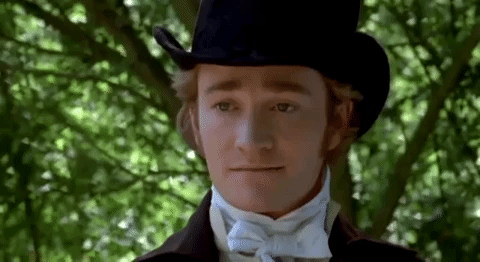
Olivia Williams was a good, even great, Jane Fairfax, and in my opinion does a much better job of portraying Jane’s vexation than, say, Polly Walker did (more on that next time), while still quietly looking like she’d like to arm-bar Frank rather than take his vulgar teasing lying down.
She also has the distinction of being the only Jane Fairfax who’s singing REALLY blows Emma’s out of the water, and I like that all of the songs she sings are in languages other than English (primarily Italian I think?). This achieves the double whammy of showing how much more accomplished she is than Emma by emphasizing that not only does Jane sing and play better, but she knows languages too.
Samantha Morton is a superb actress whom I love and I was sort of appalled at how she looks in this movie. Is she dying of a wasting illness? She looks like a gust of wind will carry her away, although since she looked the same in the 1997 Jane Eyre (In which she played the title role under similarly appalling direction) perhaps that was just her look that year?
Dominic Rowan, as Mr. Elton, is… there’s a perfect word to describe it and I just can’t think of it right now. Like every other young man in this movie (other than Robert Martin) he’s got this feeling of skeeviness to me but it’s more than that. It’s a dweebie-ness as well. This is so dissatisfactory to me because Mr. Elton is supposed to have every appearance of charm and agreeableness, with his only obvious fault being his over-eagerness to ingratiate himself to Emma and some rather vulgar locker-room type talk about marrying for fortune. He’s just so… (I’ve hit upon it now after some discussion with my sister) dingy. He looks less like a “very handsome young man” who “knows the value of a good income” and more like the kind of guy that scrubs up okay, but still you can tell from the rumple of his clothes and the pizzaroni odor wafting from him that he lives in his mom’s basement.

The shining star for me in this production was Alistair Petrie as Robert Martin. I love him as an actor and especially after watching him in Cranford, I think he was an excellent choice for Harriet’s Mr. Martin.
Davies wrote the character to be a little more romantic (Actually buying Anne Radcliffe’s The Romance of the Forest, where originally Mr. Martin was supposed to forget to – something Emma uses as a mark against him to prove how he will age into an “gross vulgar old farmer” who is “obsessed with profit and loss”.)
I especially like an inserted scene where Mr. Martin, working in his field, sees a distressed Jane Fairfax from afar as she is walking home (I think from Donwell). I thought it drew an interesting parallel between two emotionally wronged characters that otherwise would have no interaction.
What’s with Mrs. Elton (Lucy Robinson)? I don’t think nearly enough people question this. I’ve seen it explained away as her being from Bristol and trying to make herself sound more hoity-toity to hide the fact that she’s New Money. I’m not positive on what a Bristol accent sounds like (For that is where Augusta Hawkins is from) but… this sounds like an American trying to sound posh. At some points she almost sounds Texan. It’s all very confusing, because the actress is British.
Prunella Scales lists among her achievements being an outstanding actress and comedienne, as well as bringing into the world Samuel West, one of my all time favourite British screen crushes. She's probably best known for her work on Fawlty Towers, so its interesting to see her range as much less inscrutable Miss Bates. Her performance is by the book, but so much more engaging than Constance Chapman's 1972 offering, although i find her perhaps a shade too placid. She lacks a certain nervousness that I associate with the character (for more information, see my previous review.)
As for Bernard Hepton as Mr. Woodhouse, I can only say I. Didn’t. Like. Him. I have every consciousness of this being a personal bias. I have seen him play too many insufferable characters in too many things to like him as Emma’s lovable if tiresome father. This isn’t a knock on him or his performance; his reaction to Mrs. Elton is some great subtle visual comedy, this is just a me thing.
Another one of the better characterizations, though a relatively small role, is John Knightley. Played by Guy Henry, he is shown to be a good father, and an “Gentleman-like man”, with just the right blend of good humor and caustic comments.
Sets & Surroundings
I’d never paid MUCH attention to or questioned the houses and interiors used for estates in Austen adaptations until the 2020 version of Emma used such ridiculously lavish houses for relatively provincial gentry it forced me to sit up and pay attention. I think the houses used in this version are mostly suitable.
The part of Donwell Abbey’s exterior is played by Sudeley Castle in Gloucestershire. The Key words for Donwell from the text are “rambling and irregular” and while perhaps not as big as the Former Claremont House (Which, it is believed, was Austen’s inspiration for Donwell Abbey) it definitely is a suitable architectural style and situation and furthermore, having been purchased in the 19th century by a glove manufacturer and having been up to that point left in a little bit of a state of disrepair, fits the “neglect of prospect” Austen describes as well. Its interiors are a cobble-work of the Great Hall at Broughton Castle (Oxfordshire), various rooms at Stanway House (Gloucestershire), and the Strawberry beds at Thame Park (Oxfordshire)

(Top, left – Sudeley Castle; Bottom left – Trafalgar Park; Right – Dorney Court)
Trafalgar Park in Wiltshire and its interiors (a minty sage-green drawing-room fitting in perfectly with the mint-chocolate – primarily chocolate – color palette of the production) played the role of the Woodhouse’s home, Hartfield. A typical Georgian style house in red brick, I believe is consistent with Austen’s description of a “well built, modern house”.
Dorney Court in Buckinghamshire was used for Randalls, Mr. Weston’s recently purchased estate. It’s a Tudor style red brick house and it looks pretty on the mark from the front facade, but I think it’s still too big for a “small estate” with only two guest rooms (Although there’s no panic about the snow in this version – perhaps because it’s already snowing when they set out.)
My biggest problem is the lighting of this movie. I understand natural lighting and I LOVE it when you can even it out – but it is so dark in the evening scenes that it adds to the colorlessness of an already colorless production.
Fashion
Oh Jenny Beavan. You are a well-respected costume designer with good reason. However, I know that most of these costumes are rentals, but why is every-fucking-thing in this movie a shade of brown, beige or green?
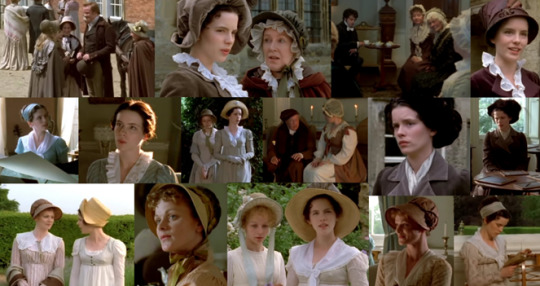
As you can see, a rich tapestry of brown and beige. And this isn’t selective. this is (just about) every day-wear outfit in the movie (barring repeats and a few exceptions that I’ll give mention to below.)
Emma’s outerwear is brought to you by Hershey’s Chocolate. Also I’m not certain but I think that her light brown redingote is the same one as Elinor’s in the 1995 Sense and Sensibility? If anyone can confirm, drop it in the comments.
Perhaps the evening wear will be more colorful?

Barely – Mrs. Weston in a brownish orange; Mrs. John Knightley in an orange-ish brown; Emma gets a dark blue? Or is that just the wintery glow from the window on a dark green velvet? Green (either so dark it’s almost black, or washed-out mint) appears to be the only color Emma is allowed to wear other than brown or ivory/white. Even her gown for the Crown Inn Ball (upper right) is an underwhelming and rather dingy ivory. The champagne number she wears for Christmas at Randalls is not only lack-lustre, but also sports what I’m now calling a “Bridgerton Bust” (where the Empire waist comes up too high, with the seam apparently resting across her bust rather than under it.)
The pink frock (seen properly only from the back) on Mrs. Weston is as close to real color as a main character gets in this production, and can be recognized as one of Jane Bennet’s dresses from the previous year’s Pride and Prejudice.
Even Jane Fairfax doesn’t get a break. Rather than putting her in Jane Fairfax Blue ™ (honestly, Jane Fairfax being costumed in blue is so consistent at this point Crayola should just name a crayon in her honor - this is gonna come back in future reviews) she gets a black-green evening number with no trim at all, and a succession of what the Ladies over at Frock Flicks like to call the “Dumpy Regency Little White Dress”, or drab gray-blues.
Some of the background dancers in the Crown Inn Ball scene get to wear pink! Why not put Harriet in a nice pink frock for this scene?! Why is this so difficult?!
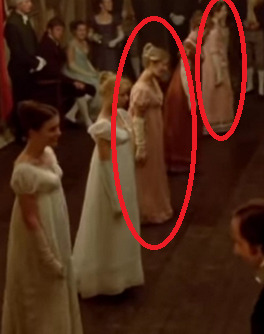
Strawberry picking at Donwell is the only time main characters are consistently wearing identifiable colors that aren’t brown or green: Mrs. Weston in pink, Miss Bates in (oddly the most colorful dress of them all) a nice refreshing lavender blue; Jane gets grey/blue and Mrs. Elton, a pastel mint. Harriet is also given a little break in Mrs. Elton’s introduction scene in a (very) pastel blue frock, while Emma sports white (with a trademark green shawl.)
So how about the...
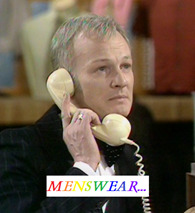
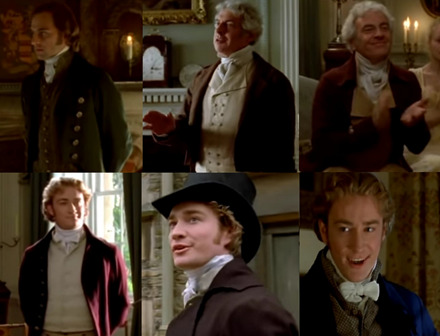
Similarly dull. I almost screamed for joy when I saw that Frank’s jacket was actually blue, and a vibrant blue at that. (The red is too close to brown, I’m sorry.)
So yes, in short the costumes, while perfectly technically accurate (I didn’t get a lot of caps of them but the trousers sufficiently tight, not that I care to look), are drab as a peahen.
As always I’ll outsource any dancing critique by linking Tea With Cassiane on YouTube, since I find her insights on the approach to dancing in Austen adaptations just fascinating and I would like to share such witty and informed reviews.
The Andrew Davies of it All…
*Strong Opinions Ahead*
There are so many reasons why this adaptation isn’t for me. First of all the very idea of making Emma, one of Austen’s most socially complex works (certainly her most vivid) into a sparse 107 minutes is baffling to me. Perhaps I can understand if it’s a Theatrical release but this is a TV production. Why not at least make it a two part special?
And besides the issue that, in order to make this fit the time frame, the story is severely truncated, there’s… the Andrew Davies of it all.
I have some issues with Andrew Davies’ screenwriting for this adaptation particularly. A LOT of issues. Where does one start? I think Knightley is a good place.
It’s not just the casting I don’t like here; but it does say something to me that they chose Mark Strong for this role. It’s a casting decision I discovered with disbelief when I first saw clips from this version in a Period Drama men compilation video on YouTube. I mentioned above that I know Mark Strong as unpleasant characters with man-handling habits. That’s the kind of role Mark Strong is associated with because that’s just what he does well. And I think this played into the casting here, because Davies’ interpretation of Knightley is a bit… fierce. He shouts SO MUCH in this movie and in scenes like the Harriet Smith debacle (where Mr. Knightley of the book even gets a bit angry with Emma) I can understand this, perhaps. But in the book Mr. Knightley takes many pauses to collect and calm himself, because his goal is not to quarrel with Emma but to argue a point. 97 Knightley takes no such pauses and spends the whole scene in what some might call an escalating rage.
Knightley’s cheerful arrival to Hartfield to tell Emma that Robert Martin intended to propose to Harriet is cut out so we start right off with his indignant exclamation of “She refused him?!” and it’s all go from there. To make matters worse, Emma’s own arguments are crippled by Davies’ editing. Many of her more (what might even latterly be considered “feminist”) arguments are cut out. In fact once Knightley gets going, he juggernauts his way through all of his rebukes and speeches from the book, but Emma hardly gets a word in edgewise after arguing that Robert Martin is not Harriet’s equal. What Austen wrote as a heated debate is turned by Davies into a one-sided tirade. (By don’t take my word for it, watch the clip.)
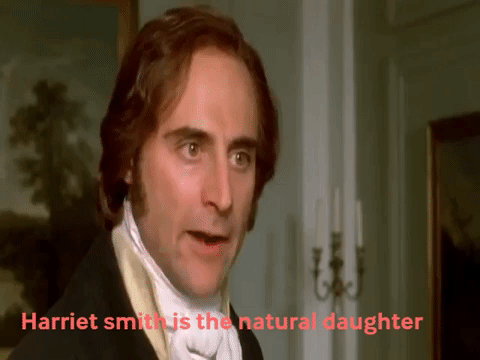
The final cherry on top is having Emma, after Knightley leaves the room with the last word firmly in his grasp, childishly pout “You are wrong Mr. Knightley, and you will see you are wrong and then you will be sorry.” I half expected her to cross her arms and stomp her foot. Worth noting is the fact that Davies adds an additional “It was badly done. Emma,” in this scene where there was none in the book. Rather overkill to my mind. Is this his catchphrase?
At Box Hill, Davies has Knightley begin his climactic rebuke of Emma’s insulting behavior by grabbing her arm and hauling her aside, and concludes by leading her, still holding her arm, to the carriage. Well at least he doesn’t shout at her in this scene; but again, all but one of Emma’s responses are cut out and she stands there, pouting until Mr. Knightley leaves and then she bursts into tears.
When Mr. Knightly proposes to Emma I was feeling good about this scene, until he dropped the “I held you when you were three weeks old” line, and I immediately felt uncomfortable. Maybe you DON’T want mention how you held her when she was a baby after you asked her to MARRY you. But perhaps worse is Emma’s response to the line: “Do you like me as well now as you did then?”
Bringing up holding Emma when she was three weeks old at the proposal (A line which was not in the book) is bad enough but there seems to be a peculiar repeated emphasis on Knightley recalling Emma as a baby. He dragged it up previously when he and Emma make up after the Harriet debacle, as he holds John and Isabella’s baby daughter (whose name, I would mention, is Emma.) In this instance too, the line is a Davies addition.
Let’s talk about Knightley’s strawberry line.
This is delivered in voice-over as a transition to the strawberry picking party at Donwell, and is portrayed as a formal invitation: “Mr. Knightley invites you to taste his strawberries, which are ripening fast.”
At first I was confident that I was reading too much into this (but I think at this point I can safely say that I’m not). I can’t help bursting out laughing every time I hear that line. It was a questionable way to word that if you ask me, especially considering that this is (once again) NOT the line in the book, and it was NOT a formal invitation. It was said to Mrs. Elton and intended to be a joke.
“You had better explore Donwell then,” replied Mr. Knightly “That may be done without horses. Come and eat the strawberries; they’re ripening fast.”
‘ If Mr. Knightly did not begin seriously, he was obliged to proceed so...’
And here I thought Janeites hated adaptations that cut out “Miss Austen’s biting wit.”
To top it all off, we have Frank Churchill (Who I have already pointed out is a bit of a creep in this adaptation and even more detestable than he already was as Austen wrote him) praising Jane: this would be fine, if he wasn’t drooling into Emma’s ear about the turn of Jane’s throat, (He actually utters this line)

and how fine his dead aunt’s jewels will look against her skin. May I just be the first to say “Ehewhegaugh”.
I juxtapose this with the book where Frank's lines are almost exactly as Davies renders them, except Jane Austen never wrote the "have you ever seen such a skin?" Line. The difference i have highlighted in bold:
"... She is a complete angel. Look at her. Is she not an angel in every gesture? Observe the turn of her throat. Observe her eyes as she looks up at my father. --- You will be glad to hear that my uncle intends to give her all my aunt's jewels. They are to be new set. I am resolved to have some in an ornament for the head. Will it not be beautiful in her dark hair?"
Because talking about how pretty your fiancee's hair is, is normal and marginally less creepy than talking about what a fine skin she has or how lovely your (i cannot stress this part enough) dead aunt's jewels will look against it. Davies' script also makes no mention of having them reset, which makes me think he’s talking about the actual necklaces and bracelets Mrs. Churchill would have worn.
But hey, maybe its just a me thing.
Harriet Smith’s story suffers, primarily, I can with some candor admit, due to the time constraints. After Mr. Elton is married, we never see Harriet in any distress. It’s almost as though she’s forgotten all about it! Emma never has to appeal to her to exert herself or to move on. Perhaps this is better than Doran Godwin’s Emma gaslighting Harriet and manipulating her by constantly chastising her for… well general heartbreak (but that’s a bugaboo for a different review.)
My last complaint of note is that ludicrous harvest feast at the end of the movie. The whole concept of this scene just does not seem at all Janely to me. I was under the impression that I was meant to be watching an Austen. Not some bullshit Thomas Hardy knock-off. This is another Davies touch and I hate it more on the principal that it is one of his numerous, obsessive tweaks made solely to point out the existence of the lower classes.
If Davies wanted to show Mr. Knightley’s being an attentive landlord and gentleman farmer then I don’t see why he couldn’t just show Knightley actually running his farm?
“Okay’, you might say, “but I think the highlighting of the servants is to show how good Knightley is by treating them like real people compared to everyone else”, and I hear you. And in the situations where that is the case, like him greeting the Woodhouse’s butler and asking after his family I think that’s totally fine and in character. But things like the servants moving the knee cushions every time someone moves down the line at strawberry picking, to me, is AS ridiculous as the “servants clipping the lawn on their hands and knees with tiny scissors” trope. Like we get it, people took the lower classes for granted, but I don’t think it’s a stretch to say that it would be easier and more realistic to have Mrs. Elton have to move her own knee cushion. I don’t think Knightley would instruct his servants, who he treats so well, to do that kind of thing, but you could write in Mrs. Elton’s expectation of it if you wanted. It seems like the kind of thing she would expect the landed gentry to do.
Screenwriter for some of the best loved Austen’s (including the sacrosanct 1995 P&P Mini-series and my favorite Sense & Sensibility), I thought of Davies for years as untouchable; until Sanditon happened and left everyone who knows anything about Jane Austen really wondering where this mess came from. I put it to you now that it was there in Davies all along.
Davies admitted, when talking about the drastic “Sexing Up” he did in Sanditon that he felt Austen’s works could have done with a bit more sex appeal. I can hardly disagree and additions like Darcy’s little swim in the pond and Edward Ferrars’ angsty wood-chopping are welcome and beloved. But it seems that what he really wanted all along was what he gave us in Sanditon; and finally, without actual source material to stand in his way, he had a chance let his dirty old man show and gave “Austen” the sexing up he thought it needed.
And it gets more troubling as you look back.
In my opening paragraph to this review I mentioned a 2008 blog post that not only agreed with me that there’s something very off about this screenplay, but gave me some possible insights as to why. It points out numerous things that I have always questioned in this version but have never seen anyone else criticize (though I am informed that more recently it has gained its’ share of critics). In fact the post itself actually points out that almost no one in the Austen Blog-sphere had (at that point) criticized this version’s faults in any meaningful way, but my favorite thing about it is that it points out what you find in Davies’ screenplay if you pay careful attention to it “Rather than sitting there and cataloguing what is “technically faithful and whatnot”.
Many Austen bloggers have kind of been playing Miss Taylor to Davies’ Emma for some two decades and change.
The most troubling thing of all is Davies own comments on Mr. Knightley (and other things, more inferred in his screen play). All of the aspects of this interpretation of Knightley that I mentioned earlier seem to stem from the fact that, as quoted in Sarah Caldwell’s book on his works, Davies thinks there’s “Something odd going on with Knightley.”
Davies clearly reads foul, or at least questionable, intentions in Mr. Knightley but I find it interesting that, rather than cutting out material he may have found troubling about Knightley in the book out of his screenplay, he doubled down by adding MORE troubling lines and situations (that were never in the book at all, and imagined solely by himself) in a romantic story with a happy ending.
Perhaps there’s not so much something odd going on with Knightley, Mr. Davies, but with you.
Final Thoughts
At this point I might ask what it is that everyone sees in this version that makes them think it’s so perfect, but that would be a bit pointless since all I’ve read since I discovered this version is people on elaborating on just that and I don’t care to hear much more.
“The lines are verbatim!” textually, perhaps, but it’s the ones that added that trouble me.
“The leads have so much chemistry!” I’m glad you think so, but I can’t find it.
“The costumes are damn near perfect!” And brown. So, so very brown.
As a 90's TV period drama, this version is pretty standard. It sticks to the book (except in those places where the screenwriter saw fit to dabble with some subtle but troubling suggestions about the characters.) And if it floats your boat, as always I'm glad it gives you what you want from the story.
I know I hold unpopular opinions on Jane Austen adaptations, and perhaps this is one of them, but every time I watch this version I feel the need to read the book as a cleanse. Perhaps Davies’s ferocious Knightley was simply a pendulum swing reaction to Douglas McGrath’s almost too laid back interpretation in the Miramax film from earlier in 1996, but even if that’s the case it’s just uncalled for and is my biggest turn off for this film.
Tone: 3
Ribbon Rating: Badly Done! (40 Ribbons)
Casting: 5
Acting: 6
Scripting: 4
Pacing: 2
Cinematography: 4
Setting: 3
Costumes: 5
Music: 2
Book Accuracy: 6
29 notes
·
View notes
Photo
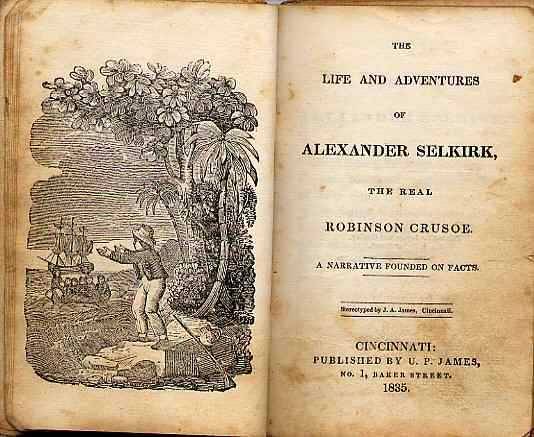
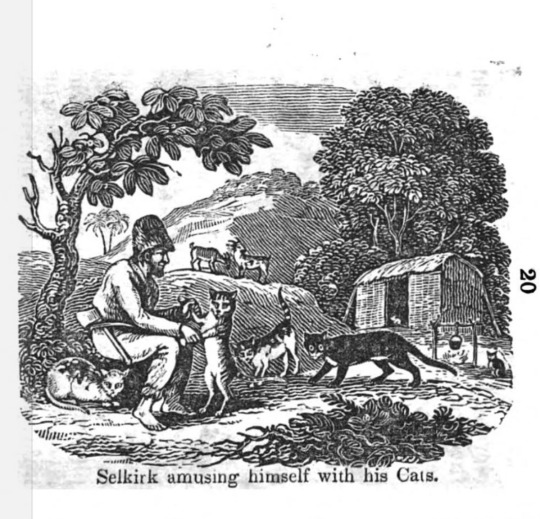
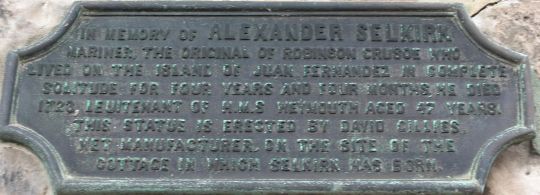
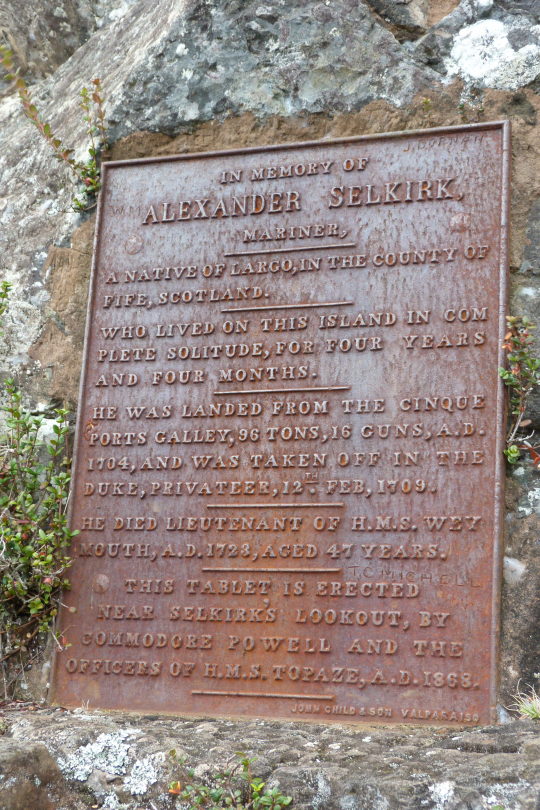

December 13th 1721 saw the death off the coast of West Africa of Alexander Selkirk
Selkirk was the Scot whose experiences inspired Daniel Defoe's "Robinson Crusoe", he was the son of a shoemaker and tanner in Lower Largo, Fife born sometime in 1676.
Young Alex was a quarrelsome character who was often falling foul of the church elders, he liked the usual Scottish pastimes of drinking and fighting and it was in 1693 after an altercation in church he had to flee Scotland, the church records say it was "indecent conduct in church", god knows what he did but the record goes on to say "did not appear, being gone to sea"
He was back in Lower Largo and back in trouble by 1701, this time it was a brawl with his old man and brother, he had to get out of Lower Largo or would probably end up at the end of a noose, so what better occupation for a wayward laddie of Alex's nature than to become a Pirate. Well not quite a pirate, a Privateer which was the nearest thing to being one, it was legalised Piracy where a Merchant ship could attack and take the spoils from enemies of whatever country authorized, in this case it was an English ship called Cinque Ports and they were involved in the War of the Spanish Succession, so they were after French and Spanish ships mainly in the South Atlantic.
Anyway after a few years of plundering Selkirk and the crew had pulled into an island called Más Afuera , four hundred miles off the coast of Chile. Selkirk once again showed he was a handful and argued with the ship's captain, Thomas Stradling, that the ship wasn't seaworthy and they should make repairs before departing.
Tempers flared, and Selkirk said he'd rather stay on the island himself than risk being on a sinking ship. Stadling duly obliged leaving him on the island with a few supplies, including a musket, gunpowder, and a few tools.
Oor Andrew initially stood fast, hoping the crew would side with him. When no one else did, he begged to be let back on the ship, but to no avail. He must have looked on despondently as the ship sailed away.
On the surface, Más Afuera was a great place to be stranded. Meat was readily available in the form of wild goats and spiny lobsters. A freshwater stream ran through the island. Wild cabbage, pepper, and plums grew in the jungle. There were no predators or dangerous animals, and probably the most important thing for him, nobody to argue with!
The early months, however, proved difficult for Selkirk. He sank into depression, and rarely bothered to pursue the food all about him. It's said that at night, rats would crawl into his shelter and bite his feet.
After months of listlessness, Selkirk came to accept his fate. He domesticated wild cats to keep the rats away and provide company. He began hunting goats on the island and grew adept at running them down. His feet grew tough and calloused from running over the land barefoot.
Selkirk had another advantage. His father had been a tanner, and Selkirk learned how to tan hides at a young age. He used this skill to make clothing out of goat skin.
Over the next several years, Selkirk came to embrace his solitude. The only interruption he encountered was when a Spanish ship landed on the island. Selkirk fled from them and hid up a tree as the away party passed underneath. To pass the time, Selkirk supposedly read the Bible, sang, and prayed the days away until he was finally rescued his long-awaited deliverance came on 2nd February 1709 when two privateering ships, the Duke and Duchess stopped off at the island.
Thomas Dover led the landing party that met Selkirk. After four years and four months without human company, Selkirk was almost incoherent with joy. The Duke's captain and leader of the expedition was Woodes Rogers, who mischievously referred to Selkirk as the governor of the island. The agile castaway caught two or three goats a day and helped restore the health of Rogers' men, who were suffering from scurvy.
Rogers wrote an account of his expedition, A Cruising Voyage Round the World, it provided the earliest written accounts of Selkirk’s adventure and served as the basis for many other literary works inspired by Selkirk, including the most famous of them Defoe's Robinson Crusoe. Not only did he get a book based on his life, but in the end, it seems Selkirk got the final I-told-you-so. The ship that he deemed not seaworthy and refused to board did end up sinking, killing almost everyone on board except Stradling, who ended up in prison. He ended up in England in 1712 and after a few months in London, he began to seem more like his former self again. In September 1713 he was charged with assaulting a shipwright in Bristol and may have been kept in confinement for two years He returned to Lower Largo, where he met Sophia Bruce, a young dairymaid. They eloped to London early in 1717 but apparently did not marry. He was soon off to sea again, having enlisted in the Royal Navy.
While on a visit to Plymouth in 1720, he married a widowed innkeeper named Frances Candis. He was serving as master's mate on board HMS Weymouth, engaged in anti-piracy patrols off the west coast of Africa, when he died on 13 December 1721, succumbing to the yellow fever that plagued the voyage. He was buried at sea.
There is a statue in Lower Largo and a plaque that reads
"In memory of Alexander Selkirk, mariner, the original of Robinson Crusoe who lived on the island of Juan Fernández in complete solitude for four years and four months. He died 1723 Lieutenant of HMS Weymouth, aged 47 years. This statue is erected by David Gillies, net manufacturer, on the site of the cottage in which Selkirk was born."
A plaque was also erected on a rock on Más Afuera, which has now been remaned Isla Alejandro Selkirk/ Alexander Selkirk Island.
15 notes
·
View notes
Photo

Ada Wilson
Ada Wilson (b. Zoa Ada Bisdey Elbury)
Birth date: 1863 Attacked: March, 1888 (ca. 25, survived) & 25th June 1891 (ca. 28, survived) Death (age): August 24th 1952 (aged 89)
Complexion: ? Eyes colour: ? Hair colour: ? Height: ? Ocupation: Seamstress, tailoress, waterproof hand clothes making.
Resting place: ?
***
Early life
Zoa Ada Bisdey Elbury was born in 1863 in Bristol, to Henry Edwin Elbury and Emma Fry. They married shortly before she was born. He had been born and bred in Bristol, and she was from Somerset. Henry’s father and elder brother were both stoneware potters – he followed them into this occupation, and seemed to do reasonably well. By 1871, Henry and Emma had been married for eight years, and had three children – Ada, Charles and Henry – and a servant. They lived in what seems to have been reasonable comfort on Clarence Square, in Bedminster, Bristol.
In the circumstances, it is hard to know whether the family’s next appearance in the census – at 39 Stratfield Road, in Bromley St Leonard, signified a reversal of fortunes. If guests and auxiliaries were anything to go by, then they had a lodger in 1881, rather than a servant. There were more mouths to feed (Rose, Emma and Thomas) and Ada, now 17, was earning her living – as a tailoress.
1888 Attack
Ada Wilson lived at 9 Maidman Street, Burdett road, a small thoroughfare lying midway between the East India Dock and Bow roads in Bow, a district in the London Borough of Tower Hamlets in East London. On March 28, 1888, at 12:30am while she was at home she was attacked by a man of about 30 years of age, 5ft 6ins in height, with a sunburnt face and a fair moustache. He was wearing a dark coat, light trousers and a wide awake hat. According to Ada, the man was a completely unknown, and forced his way into the room and demanded money, and when she refused he stabbed her twice in the throat with a clasp knife and ran, leaving her for dead. It is reported that nearby neighbours almost captured the man, but he found his escape.
Witness and neighbour Rose Bierman, a young Jewess who lived upstairs with her mother at the same building as Ada, explained that she knew Ada was married but didn’t know her husband, and that she was always getting visitors. About the man who attacked her she said that “whether he was her husband or not I could not say.(…) Well, I don’t know who the young man was, but about midnight I heard the most terrible screams one can imagine. Running downstairs I saw Mrs. Wilson, partially dressed, wringing her hands and crying, ‘Stop that man for cutting my throat! He has stabbed me!’ She then fell fainting in the passage. I saw all that as I was coming downstairs, but as soon as I commenced to descend I noticed a young fair man rush to the front door and let himself out. He did not seem somehow to unfasten the catch as if he had been accustomed to do so before. He had a light coat on, I believe. I don’t know what kind of wound Mrs. Wilson has received, but it must have been deep, I should say, from the quantity of blood in the passage. I do not know what I shall do myself. I am now ‘keeping the feast,’ and how can I do so with what has occurred here? I am now going to remove to other lodgings.“
A couple of young women rushed up to two police-constables on duty outside the Royal Hotel, and said that a woman was being murdered. The two constables, Ronald Saw and Thomas Longhurst, immediately ran to the house indicated, and there found Ada Wilson lying in the passage, bleeding profusely from a fearful wound in the throat. Doctor Wheeler, from the Mile End road, was instantly sent for, who, after binding up the woman’s wounds, sent her to the London Hospital (Sophia Ward), Whitechapel, where Dr William Rawes ascertained that she was in a very critical condition.
Detective-Inspectors Wildey and Dillworth had charge of the case, and looked for the attacker. Lloyd’s Weekly Newspaper, April 1, 1888 issue reports that “subsequent enquiries … revealed the fact that a dispute arose between the woman and a man who she states is her husband … He was pursued for some distance by a neighbour … But the would-be murderer sharply turned a corner, and was soon lost in the labyrinth of streets.” No conviction was ever obtained. By the time Ada Wilson returned home from the hospital, on April 27 1888, all hope of finding her attacker – or of proving anything in a court of law – seemed to have disappeared.
Authorities at the time of the 1888 Whitechapel murders made no link between her attack and those murders and she never was questioned again.
Mrs Wilson
On 2 January 1889, a little over eight months after returning from the hospital, she married Samuel Wilson (she was already using his surname as many women did when lived with their common-law husband but weren’t legally married) at the registry office in Bristol. Samuel was older than Ada: he said that he was thirty-three on his marriage certificate. He described himself as an engine fitter. He abandoned Ada in or around February 1891; she returned to her parents’ house in time for the 1891 census, at which point the family resided at 78 Rounton Road, Bromley St Leonard. According to the enumerator’s records, Ada was married, twenty-seven years of age, and a “waterproof hand” – making waterproof clothing from India rubber. This profession – lightly skilled, but perhaps quick to be picked up once one had the job – perhaps suggested a degree of specialisation, but Ada was still firmly in the clothing-manufacturing trade.
Ada was attacked by her husband again on June 25 1891. He was drunk and asked her money, which she didn’t have, and he asked to live with Ada again, but the proposition failed to appeal to her. “Go to work,” she said, “and be different”. He was arrested. According to the Daily News, July 8, 1891 issue, “Samuel Wilson, 40, was indicted for maliciously wounding Ada Wilson, his wife” who was also injured with a knife on her neck. Her parents were also assaulted. When the case came to the Quarter Sessions at Clerkenwell on 7 July 1891, Samuel Wilson defended himself. The chairman Mr. Richard Loveland-Loveland, said that “the prisoner was a very dangerous character, and therefore he would be sentenced to six months’ imprisonment with hard labour.” She asked for a separation.
Little more is seen of Samuel, or Ada. Whether they ever took out their separation order is not known. In December 1898 Ada’s brother Henry had a daughter and named her Zoa Lavinia Elbury.
Later life
Zoa Ada Wilson died on August 24th 1952, aged 89 of a pneumonia, at the Whipps Cross Hospital in Leytonstone, London; she was the widow of engineer Samuel Wilson.
Aftermath
Authorities at the time of the murders made no link between her attacks and the Whitechapel murders. Samuel Wilson was never arrested for those crimes.
***
To know more:
Casebook website - Casebook Message Boards - Press report (from Casebook) - Press report (from Casebook) - Press report (from Casebook) - Biographic details from Casebook website - Wiki Casebook - Casebook Forums
JTR Forums
Jack The Ripper.org - Press reports (from Jack The Ripper.org)
Jack The Ripper Tour
The Jack The Ripper Tour
Jack The Ripper Map
Crimenes de Whitechapel (Spanish)
Jack El Destripador (Spanish)
Red Jack (Italian)
BEGG, Paul (2013): Jack The Ripper. The Facts.
BEGG, Paul & BENNETT, John (2014): The forgotten victims.
BEGG, Paul; FIDO, Martin & SKINNER, Keith (1996): The Jack The Ripper A – Z.
EDDLESTON, John J. (2001): Jack the Ripper: An Encyclopedia.
FIDO, Martin (1987, 1993): The Crimes, Detection and Death of Jack The Ripper.
HINTON, Bob (1998): From Hell… The Jack The Ripper Mystery.
JAKUBOWSKI, Maxim & BRAUND, Nathan (1999): The Mammoth Book of Jack The Ripper.
MATTHEWS, Rupert (2013): Jack the Ripper’s Street of Terror: Life during the reign of Victorian London’s most brutal killer.
RIPPER, Mark: Ada Wilson. Doubly Unfortunate, in Ripperologist no. 125, April 2012.
SCOTT, Christopher (2004): Jack the Ripper: A Cast of Thousands.
SUDGEN, Phillip (1994): The Complete History of Jack The Ripper.
#Ada Wilson#Zoa Ada Bidsey Elbury#1863#1860s#1888#1891#1952#1880s#1890s#1950s#victim#victims#Rose Bierman#Maidman street#Doctor Wheeler#Dr William Rawes#samuel wilson#PC Ronald Saw#PC Thomas Longhurst#Richard Loveland Loveland#Detective Inspector Wildey#Detective Inspector Dillworth#Bow
24 notes
·
View notes
Text
youtube
sweater custom logo,knitwear manufacturers in india,wool sweater manufacturers in karachi
YS-SWEATER MANUFACTURING https://sweatermanufacturing.com
Email:[email protected]
sweater custom logo,knitwear manufacturers in india,wool sweater manufacturers in karachi sweatshirts & hoodies pink,oversized pullover hoodie wholesale,women cardigan sweaters outfits,pantalones de viscosa para mujer,sueter crochet para niña,knitting custom,sleeve knitted crew neck knit mohair sweater men,cashmere women scarf,sweaters 5t,thermal sweater hoodies,mens cashmere quarter zip sweater,terry fabric vs fleece,sweater women dentelle,zebra design sweater for women's,5 hour baby sweater matching hat,mending holes in knitwear,pulle homme chic,ugg replicas,chompas de coreanos,spiderman sweater adult,men's full zip up cardigan sweater,hoodie sweater online shop,mohair cropped jumper,ladies cardigans jd williams,pink king skirt and sweater set,yellow cardigans for women,farmers knitwear,women's jacket ralph lauren,button down sweater,cardigan makers,sweater custom logo,knitwear manufacturers in india,wool sweater manufacturers in karachi customized denim jumper,Women’s sweater customization https://sweatermanufacturing.com/customized-denim-jumperwomens-sweater/ sweater custom logo,knitwear manufacturers in india,wool sweater manufacturers in karachi sueter cuello v hombre,pullover sweater two pieces,ballet sweater, dress long,mock neck long sleeve women,long sleeves custom jacquard pattern sweater,paris sweater,weight scale jumper,designer dog sweater,tan women's cardigan,aran wool mens jumper,christmas clothing for women,t shirt and cardigan,baby cashmere sweater,women preppy saililng pullover sweater,sueter rosado para mujer,z supply pullover,fine cardigans for women,sueter sin manga,conjunto mujer de tejido,mens italian sweaters,womens half zip pullover,knitted jumper dress and cardigan,trui jurk kerst,how to change a sweater into a cardigan,cardigan sweaters for men 6x,sweaters for women hoodies light,jacket and cardigan kids,sweater custom logo,knitwear manufacturers in india,wool sweater manufacturers in karachi maker’s mark christmas sweater,susan bristol sweaters manufacturers,custom made labels for knitting https://sweatermanufacturing.com/makers-mark-christmas-sweatersusan/ sweater custom logo,knitwear manufacturers in india,wool sweater manufacturers in karachi
#baby chunky sweater oem Firm#custom logo sweater production Firm#fleece sweater set oem company#oem&odm men pullover sweater#Youtube
0 notes